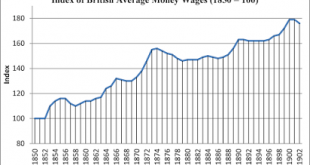Chapter 25 of volume 1 of Capital is called “The General Law of Capitalist Accumulation” and deals with the law that Marx thinks governs capitalist accumulation.Marx divides the chapter into five sections: (1) The Increased Demand for Labour-Power that accompanies Accumulation, the Composition of Capital remaining the Same.(2) Relative Diminution of the Variable Part of Capital simultaneously with the Progress of Accumulation and of the Concentration that accompanies it.(3) Progressive...
Read More »Marx’s Capital, Volume 1, Chapter 15: A Critical Summary, Part 2
Chapter 15 of volume 1 of Capital is called “Machinery and Large-Scale Industry” and examines the role of machines in developed capitalist production in the 19th century.Part 1 of this review is here. This is Part 2.Marx divides the chapter into ten sections: (1) The Development of Machinery(2) The Value transferred by the Machinery to the Product(3) The Most Immediate Effects of Machine Production on the Worker(4) The Factory(5) The Struggle between Worker and Machine(6) The Compensation...
Read More »Marx’s Capital, Volume 1, Chapter 12: A Critical Summary
Chapter 12 of volume 1 of Capital is called “The Concept of Relative Surplus Value” and it deals with yet further aspects of surplus value.Marx points to another way of increasing surplus value. He considers this representation of the working day: Working Day 1: A-----------B--CWorking Day 2: A-----B′---B--C AB represents the necessary labour-time equivalent to the value of maintaining and reproducing workers. BC therefore represents surplus labour.In Working Day 2, the total length of the...
Read More »The Critical Responses to Volume 3 of Marx’s Capital and the Early Development of Marxism
Marx published volume 1 of Capital in 1867. He never published any further volumes of the work in his lifetime. Early reviews and critiques of volume 1 included Eugen Dühring (1867; 1871; 1875), Carl Knies (1873), Maurice Block (1872; 1884a; 1884b), Wilhelm Roscher (1874), Achille Loria (1884), Eugen von Böhm-Bawerk (1884); Philip H. Wicksteed (1884 = Wicksteed 1933), Richard Theodore Ely (1883), George Bernard Shaw (1885), Knut Wicksell (1893 = Wicksell 1954) and Vilfredo Pareto (1893).In...
Read More »Marx’s Capital, Volume 1, Chapter 10: A Critical Summary
Chapter 10 of volume 1 of Capital is called “The Working Day” (Marx 1990: 340), and it deals with aspects of the working day in capitalism.Marx divides the chapter into seven sections: (1) The Limits of the Working Day;(2) The Voracious Appetite for Surplus Labour;(3) Branches of English Industry without Legal Limits to Exploitation(4) Day-Work and Night-Work. The Shift System(5) The Struggle for a Normal Working Day(6) The Struggle for a Normal Working Day. Laws for the Compulsory...
Read More »Marx’s Capital, Volume 1, Chapter 9: A Critical Summary
Chapter 9 of volume 1 of Capital is called “The Rate of Surplus Value” (Marx 1990: 320), and it discusses aspects of surplus value.Marx divides the chapter into four sections: (1) The Degree of Exploitation of Labour-Power;(2) The Representation of the Value of the Product by Corresponding Proportional Parts of the Product;(3) Senior’s “Last Hour”(4) The Surplus Product. A section by section summary follows.(1) The Degree of Exploitation of Labour-Power Surplus value is generated in...
Read More »Marx’s Capital, Volume 1, Chapter 1: A Critical Summary, Part 2
Chapter 1 of volume 1 of Capital is called “The Commodity,” and presents Marx’s theory of the commodity and labour value.Chapter 1 is divided into four sections: (1) The Two Factors of the Commodity: Use Value and Value(2) Dual Character of the Labour embodied in Commodities(3) The Value-Form, or Exchange-Value(4) The Fetishism of the Commodity and its Secret. A summary of the first two sections is here. Below is a critical summary of the last two sections.(3) The Value-Form, or...
Read More »Marx’s Capital, Volume 1, Chapter 1: A Critical Summary, Part 1 (Updated)
Updated: This post is a work in progress at the momentChapter 1 of volume 1 of Capital is called “The Commodity,” and presents Marx’s theory of the commodity and labour value.Chapter 1 is divided into four sections: (1) The Two Factors of the Commodity: Use Value and Value(2) Dual Character of the Labour embodied in Commodities(3) The Value-Form, or Exchange-Value(4) The Fetishism of the Commodity and its Secret. Interpreters of Marx admit that the first few chapters of Capital are made...
Read More » Heterodox
Heterodox

